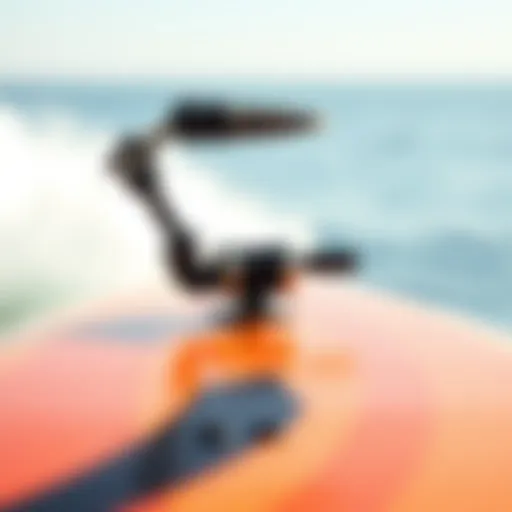Wakesurfing Techniques and Gear for Larger Riders
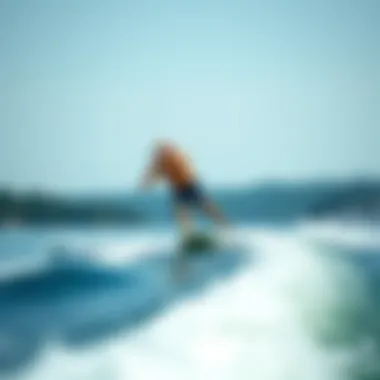
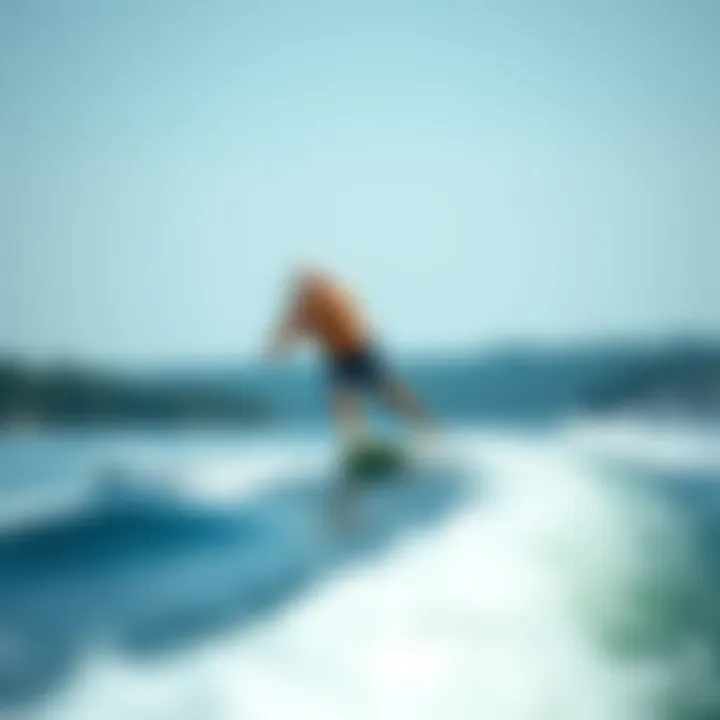
Intro
Wakesurfing can seem like a sport predominantly aimed at the slender and agile. However, this misconception couldn't be further from the truth. Big guys can find just as much joy and thrill in wakesurfing, but there are some differences in technique and gear considerations that can vastly improve their experience. As we embark on this journey through the waves, we’ll dive into tailored techniques and essential gear, making sure every aspiring wakesurfer, regardless of size, feels comfortable and confident on the water.
Techniques and Tips
Essential Surfing Techniques for Beginners
When stepping onto the board for the first time, the key is to establish balance and comfort. Here are some practical tips:
- Posture Matters: Start with feet shoulder-width apart on the board. Bend your knees slightly and keep your back straight. Think of it like standing firmly on a fishing dock rather than a tightrope, this can help center your balance.
- Use Your Core: Engaging the core is crucial. This means flexing your stomach muscles while staying loose elsewhere. Imagine trying to maintain a solid stance in the gusts of wind - that core strength will keep you steady.
- Stay Low: A lower center of gravity gives better stability. Bend those knees and lean forward slightly, but don't overdo it.
Practicing these basics in calmer water can build confidence. Once you’ve got that down, you can spice things up with a touch more speed and the thrill of the wake.
Advanced Maneuvers for Experienced Surfers
For those looking to elevate their game, mastering advanced techniques can lead to a more exhilarating ride:
- The Cutback: This move entails turning back towards the boat after picking up speed. As you gain momentum, lean into the turn with your heels, similar to how you might steer a motorcycle. The balance is essential here.
- The Surfboard Slide: For big guys, achieving a solid slide requires confidence in your turns. Approach the wake at about a 45-degree angle, redirect your weight toward the tail of the board, and allow it to break free into a sideways slide.
- Jumping the Wake: When feeling brave, jump the wake by compressing your knees and then charging off the back of the board as you reach the peak of the wake. This requires timing and balance, so don’t rush it - a smooth glide into the jump is vital.
"Taking your time to master each skill is a hallmark of becoming a true wakesurfer. Skipping steps is a fast track to frustration."
Gear and Equipment
Choosing the Right Surfboard
Picking the right board can be a game changer, especially for larger surfers. Look for:
- Stability: Wider boards offer greater stability. Brands like Ronix and Hyperlite provide options specifically designed for bigger surfers.
- Length Consideration: A longer board usually helps with buoyancy, offering that extra lift needed to stay on top of the water. Aim for boards that are at least 5'6" in length.
- Tail Shape: A square or fuller tail helps in achieving better control while riding the waves.
Must-Have Accessories for Every Surfer
The right accessories can make all the difference in your wakesurfing experience. Here’s a list of essentials:
- Life Jacket: Don’t skimp on safety. Look for a US Coast Guard-approved life vest that fits snugly without being constrictive.
- Wakesurf Rope: A rope with a little handle will give you the extra leverage needed to maintain grip and balance. Find one that's around 10–12 feet long for optimal performance.
- Sunscreen: Protect that skin because the sun can be merciless out on the water. A broad-spectrum SPF of at least 30 will keep you safe from burns and the aftereffects of prolonged sun exposure.
Setting yourself up with the right techniques and gear isn’t just about safety; it enhances enjoyment and performance on the water significantly. Whether you're just getting your feet wet or you’re ready to conquer the waves, understanding these elements will lead to a more rewarding wakesurfing experience.
Understanding Wakesurfing Basics
Wakesurfing is not just a sport; for many, it becomes a passion that intertwines with the lifestyle on water. Understanding the fundamentals of wakesurfing is key for any rider, especially for those of us who are larger in size. It is crucial to grasp how wakesurfing works, the mechanics behind it, and why these elements matter. By delving into the basics, we equip ourselves with the knowledge that enhances our riding experience while addressing specific needs that larger individuals may face on the board.
What is Wakesurfing?
Wakesurfing, at its core, is a water sport that involves riding a surfboard on the wake created by a specific boat without being directly pulled by a rope. Instead, the rider typically lets go of the rope once they catch the wave formed by the boat's wake. This sport is distinct from traditional surfing, as it occurs on the wake rather than ocean waves, allowing riders to enjoy the thrill of surfing in freshwater or saltwater lakes.
The beauty of wakesurfing lies in its accessibility. Riders of various skill levels can partake, and it can be adapted to fit different body sizes. For larger individuals, finding the right balance between board and wake size is essential. The connection to the boat, the skills required, and the feel of gliding on water create an exhilarating experience that fosters an unbreakable bond with nature.
The Physics of Wakesurfing
To truly appreciate wakesurfing, one must understand the physics involved. When a boat moves through the water, it creates waves behind it, similar to how a rock disrupts the surface when tossed into a pond. These waves are crucial because they provide the lift needed for wakesurfing.
One key principle to consider is weight distribution. In wakesurfing, the rider’s position affects how the board interacts with the wave. Leaning back or shifting weight can impact stability and control. For those who are larger, this aspect takes extra precedence. Getting the balance just right can prevent the board from sinking too deep into the wake, which can lead to a less enjoyable ride.
In addition:
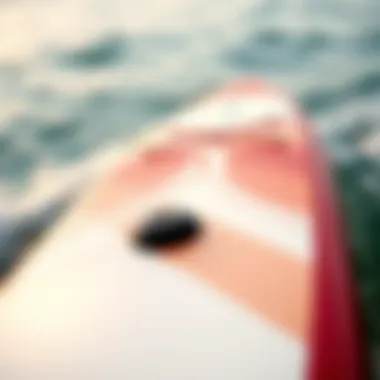
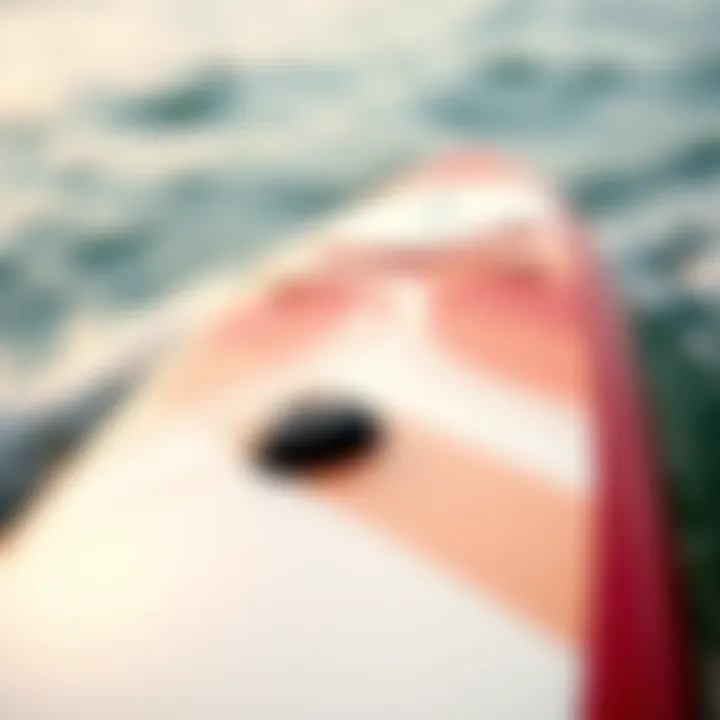
- Boat Speed: The speed of the boat significantly affects the size and shape of the wake. A faster boat generates a steeper wave, while a slower speed creates a gentler slope.
- Rider Dynamics: A rider’s weight and positioning will shape the efficiency of their ride. Larger individuals may find certain stances and movements more beneficial when adjusting to the wake’s dynamics.
"Understanding the physics of wakesurfing isn't just for the science geeks; it's the foundation of a solid ride. Knowing how to maneuver your body in relation to the boat and wake can make all the difference."
Overall, wrapping your head around the basics of wakesurfing -- what it is and the physical laws governing it -- lays the groundwork for a more successful and enjoyable experience on the water. By being aware of these elements, those with bigger bodies can navigate the waves with confidence and style.
Wakesurfing Challenges for Bigger Riders
Wakesurfing can feel like a dance on water, but it comes with distinct challenges, especially for larger riders. Understanding these hurdles can be the difference between enjoying the thrill of waves and battling frustration on the water. The essence of this section is to shed light on those specific difficulties men and women of size may encounter, while also paying heed to the benefits of addressing them directly. By grasping these challenges, bigger wakesurfers can become more confident, safe, and ultimately, more skilled on the board.
Weight Distribution and Balance
Bigger riders often face unique dynamics when it comes to maintaining balance and distributing weight correctly on the board. The fundamental principle of wakesurfing requires the rider to position their weight strategically to maintain stability. For larger individuals, this may mean revisiting the fundamentals of weight distribution.
- Center of Gravity: One primary element to focus on is the center of gravity. For those with more mass, it’s vital to position oneself low on the board and spread out evenly to counteract any potential tipping. Keeping knees bent allows for improved flexibility and balance.
- Foot Placement: The location of your feet can drastically influence your balance. A common mistake is crowding the back of the board. Instead, placing one foot just behind the center can help in finding that sweet spot where you feel in control. A simple adjustment can mean the difference between catching the wave smoothly or plunging into the water like a stone.
- Body Language: Don’t underestimate the importance of leaning. Subtle shifts in position can help maintain stability. Leaning back when you feel the pull of the wave increases your chance of staying upright.
Emphasizing firm footwork and body posture while learning to read the wave is essential. Practice becomes your ally here; the more comfortably you balance, the more the ride can become a fun experience rather than a physical struggle.
Common Injuries and Prevention
Just like any sport, wakesurfing presents its fair share of risks. Larger riders can be more susceptible to certain injuries due to their unique body mechanics and center of gravity. It’s crucial to be aware of potential injuries and take preventive measures not just to enhance enjoyment, but to maintain your health in the long term.
- Falls: Larger bodies fall differently, and often harder. Impacts with the water can be quite jarring. To safeguard against fall injuries, choose an appropriate life jacket that provides flotation while allowing mobility. Make sure it fits snugly, without being too tight.
- Muscle Strains: When trying to maintain balance, larger riders might find themselves straining their back or leg muscles. Incorporating dynamic stretches before hitting the water can reduce the chance of muscle pulls. Regular strengthening exercises focusing on core stability can also play a significant role.
- Hydration and Fatigue: Often overlooked, staying hydrated is essential. It’s easy to feel fatigued on hot days, which increases the risk of accidents. Be sure to take breaks, drink fluids, and listen to your body.
"A well-prepared rider is a safer rider." Knowing your body limits helps in avoiding unnecessary accidents and enjoying every splash in the waves.
Bigger individuals have the opportunity to redefine their experience through awareness and preparation. Each wake holds potential, where with the right approach, the challenges fade away, and the joy of wakesurfing shines through.
Choosing the Right Equipment
Choosing the right equipment in wakesurfing isn't just a matter of preference; it's a major determinant for performance and enjoyment, especially for larger individuals. The right gear can make a world of difference – between a thrilling ride and a frustrating experience on the water. Before splashing down, it's crucial to have an understanding of what gear will best support your weight, size, and skill levels.
Board Size and Shape Considerations
When it comes to wakesurfing boards, the size and shape play integral roles in how well a big guy can maneuver through the water. A larger board typically offers more buoyancy, which is critical for riders with a heavier build. It helps maintain balance and stability, allowing for smoother rides. On the other hand, the shape of the board influences how it interacts with the wake.
- Wider Boards: These offer extra stability, especially for beginners. A guy with more weight can find it easier to stay afloat and control the board.
- Length Matters: A longer board usually provides better glide over the wake. However, this can come at a cost — maneuverability may suffer.
- Tail Shape: The tail shapes, like square or rounded, affect turning abilities. A more squared-off tail can lead to sharper turns, while a rounded tail gives a smoother, gentler experience.
Choosing a board that aligns with your size and water conditions can enhance your wakesurfing experience significantly.
Rope Length and Tow Point Importance
The length of the rope used in wakesurfing is more than just a matter of personal choice; it can drastically impact performance. A longer rope may provide a more relaxed ride, which is often preferred by larger individuals who are coming into the sport. However, navigating around boat wakes becomes trickier the longer the rope.
- Standard Length: Typically, a wakesurf rope ranges from 10 to 12 feet. For big guys, opting for a slightly longer rope can allow for a more comfortable distance from the boat and better balance.
- Tow Point Scenarios: The placement of the tow point, whether it’s higher or lower, alters how the rider interacts with the wake. A higher toe point essentially allows a deeper ride into the wave, which can be advantageous for those with some experience.
Finding the right combination can elevate your experience off the dock and give you the confidence to try new tricks.
Fin Configurations for Stability
The fins on a wakesurf board play a significant role, especially for heavier riders. Proper fin configuration can transform how the board handles in the water. More fins usually mean greater stability, which is a crucial aspect for larger individuals not yet comfortable with the nuances of riding.
- 1-Fin Setup: Great for speed and maneuverability but may not deliver the stability needed for a bigger body.
- 2 or 3-Fin Setup: More common among larger riders; they provide a solid base and bring better control and balance, especially during tricky maneuvers.
Properly selecting fins that complement your specific size will enhance stability while improving your overall performance.

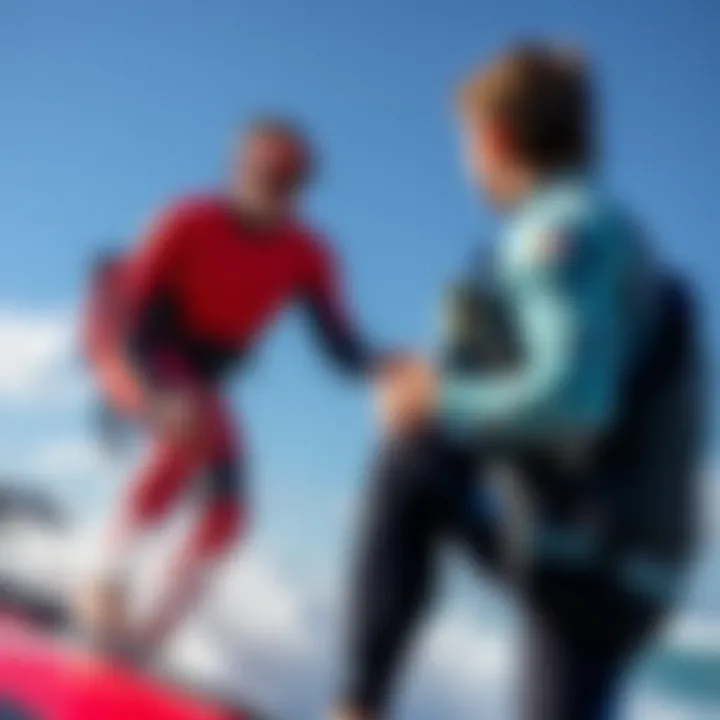
"Gear matters! The better the fit, the better the ride!"
Techniques for Successful Wakesurfing
To truly enjoy wakesurfing, especially if you're on the bigger side, mastering various techniques is essential. Techniques not only enhance your experience but also significantly boost your stability and control on the water. The importance of these practices cannot be overstated; they help in gaining confidence, reducing the risk of injury, and improving overall performance. By understanding the nuances of how to start from the boat, shift your weight effectively, and turn with ease, larger surfers can optimize their time on the water, ensuring every ride is both exhilarating and safe.
Starting from the Boat
When you’re a bigger rider, getting your feet wet can seem a bit intimidating. But starting from the boat gives you that crucial first step into the sport. The initial pull from the boat is like a rude awakening and mastering it can make all the difference.
To begin, ensure you are in the right position at the back of the boat.
- Hold the Rope Firmly: Grip the rope tightly, but keep your arms relaxed. Tension can lead to unnecessary strain.
- Keep Your Weight Centered: Balance is key. Loosen up your knees, let your weight spread evenly across your feet, and avoid leaning back too far.
As the boat accelerates, feel the surge of water beneath you. Keeping your chest forward and hips aligned with the board allows you to balance easier right from the off. Remember, it’s all about flow – try to stay in sync with the boat; when it pulls you, don’t fight against it.
"The more relaxed you are, the better you'll ride. It's not just about strength; it’s about finesse."
Weight Shifting for Control
Once you're up and riding, the dance of weight distribution becomes the crux of your control on the wakes. Mastering how to shift your weight is vital to maneuvering smoothly and maintaining stability.
Here’s how to practice this technique:
- Front to Back: Shift your weight slightly forward to gain speed and back to slow down. This subtle shift of your center of mass can significantly impact your ride.
- Side to Side: Leaning your weight to either side initiates turns or propels you into a new direction. A gentle lean can be your best friend.
- Engage Your Core: A strong core will help stabilize your body. Focus on maintaining a tight core as you shift weight, this will help keep your balance even in the wake.
It's important to be fluid in these movements. Practice will make you more instinctive in how you react to the natural pulls of the water and the boat.
Turning Techniques
Turning is where the magic happens, and it's critical to master this skill for a dynamic wakesurfing experience. Bigger individuals may find turning to be a complex feat due to the added mass, but understanding the basic mechanics can help.
- Carving Turns: Instead of relying solely on muscle, leverage the board's design. Carving involves a smooth arc, leaning into your turns while keeping your weight balanced.
- Using Fin Configurations: Different board fins can provide more grip. Experimenting with fin setup can lead to more controlled turns, allowing you to focus less on keeping steady and more on steering.
- Speed Adjustments: Your speed can alter how tight your turns are. At higher speeds, you can carve a tight turn; at lower speeds, sweeping turns feel much smoother.
Incorporating these techniques into your wakesurfing can turn each ride into an exhilarating encounter with the water. Practice makes perfect; don’t shy away from trying out these strategies.
Safety Considerations
When indulging in wakesurfing, especially for those with larger physiques, safety must take center stage. This article aims to highlight essential safety protocols and gear adaptations that ensure an exhilarating yet secure experience on the water. With the added weight of bigger riders, certain considerations come into play that, if left unaddressed, could impact safety outcomes drastically. Let's dig into some pivotal aspects that can set the stage for successful and enjoyable wakesurfing.
Life Jackets for Larger Bodies
Selecting the right life jacket is crucial for any wakesurfer, but for individuals with larger builds, it becomes even more paramount. Standard life jackets may not accommodate broader chests or larger waist sizes, risking flotation effectiveness. Here are key considerations:
- Fit is Everything: Look for life jackets specifically designed for plus-sized individuals. This ensures that they fit comfortably and securely. Jackets should allow full arm movement — essential for maintaining balance while on the board.
- Buoyancy Ratings: Larger riders require life jackets with higher buoyancy ratings to provide adequate support. The U.S. Coast Guard provides recommendations based on weight categories, which can serve as a guideline for selecting an appropriate jacket.
- Material Matters: Opt for life jackets made from breathable materials that wick moisture away. Staying cool and comfortable is crucial during the activity, and a heavy or damp jacket can hinder performance.
- Certification: Always check for U.S. Coast Guard certification. This ensures that the jacket meets safety standards and provides reliable flotation in the event of a fall.
"Safety first, fun second; if you’re not safe, you can’t have fun!"
Communication on the Water
Effective communication on the water plays a significant role in ensuring safety. Whether you are instructing someone or navigating with friends, signals and clear communication can prevent mishaps. Here are tactics to consider:
- Hand Signals: Develop simple hand signals to convey messages quickly, such as wanting to start, stop, or slow down. This eliminates miscommunication in a noisy environment typically found on lakes or rivers.
- Verbal Clearances: Before starting a session, communicate intentions clearly. For instance, discuss which direction the boat will go and establish where the falls or jumps will happen. Knowing the layout prevents confusion and ensures everyone is on the same page.
- Spotters Matter: Having a dedicated spotter on the boat can dramatically improve safety outcomes. The spotter should focus solely on the wakesurfer, providing feedback on their position relative to the boat and signaling any hazards.
- Monitoring Conditions: Always keep an eye on changing weather patterns or water conditions. By discussing conditions before hitting the water, the crew can decide on the most suitable approach to remain safe during the ride.
In summary, the waters can be unpredictable, but preparedness can go a long way in making wakesurfing a safe activity for everyone, especially big guys looking to have their day in the sun. Emphasizing life jacket suitability and establishing effective communication enhances safety while fostering a fun atmosphere on the water.


Community Insights
Understanding the insights from the wakesurfing community is crucial, especially for larger individuals looking to make their mark on the water. By sharing experiences and knowledge, the community enriches the wakesurfing landscape and creates a support system that empowers newcomers and seasoned surfers alike. In a sport that can often feel exclusive due to physical demands, community connections can provide not only encouragement but also practical advice tailored to the unique challenges faced by bigger riders.
The benefits of engaging with this community are manifold. Not only can members share tips on gear selection, but they can also offer valuable techniques and strategies, helping to bridge the gap between experience levels. Through forums and social media groups on platforms like Reddit and Facebook, insights from fellow wakesurfers often highlight essential elements like board selection, weight distribution, and injury prevention strategies. These discussions allow for a more informed approach to wakesurfing, ensuring that larger individuals can navigate the waters confidently.
"When you connect with fellow wakesurfers, especially those who have walked a mile in your shoes, it can dramatically shift your perspective on what’s possible on the water."
Experiences from Bigger Wakesurfers
The narratives crafted by bigger wakesurfers are often filled with real-world learnings. Many have faced initial trepidation but found that the water welcomes them with open arms. A common theme among these stories is the realization that weight doesn’t have to dictate one’s enjoyment or success in wakesurfing. For instance, a rider named Jake shared his journey of struggling with balance at first. He recalled how, through trial and error, he developed a sense of what boards worked best for him and how practicing stance positions turned his experience around.
They often emphasize the importance of gear that suits their body type. Boards like the Hyperlite Landlock or CWB Ride come highly recommended. In addition, many emphasize the role of camaraderie in overcoming fears and frustrations. Online forums filled with shared triumphs serve as a reminder that everyone faces hurdles—those who emerge from them with a laugh tend to enjoy their time on the water far more.
Encouraging Inclusivity in the Sport
Inclusivity in wakesurfing doesn’t stop at just welcoming big guys; it’s about actively creating an environment where all body types feel seen and appreciated. Efforts are being made within the community to address barriers that may discourage people from trying wakesurfing. Local clubs and meet-ups are starting to host dedicated sessions that focus specifically on larger individuals, providing tailored instruction and support in a comfortable setting. The wind in one’s face feels the same, irrespective of size.
A growing number of initiatives are focusing on demonstrating that the spirit of wakesurfing can be enjoyed regardless of physicality. Programs promoting diversity include Women’s Wakesurf Collective and various local groups that advocate for underrepresented communities in the sport. It’s this push that creates awareness and fosters connections, making people of all sizes feel like they belong, ultimately broadening the appeal of wakesurfing.
Sharing stories, being inspired by others, and advocating for inclusive practices help ensure that experiences on the water are enriching and exciting. Together, we can shape wakesurfing into an even more welcoming sport for all.
Environmental Awareness in Wakesurfing
In a world becoming ever more conscious about environmental issues, wakesurfing enthusiasts—especially those who are larger in stature—should not only focus on the thrills of the water but also consider their impact on natural surroundings. Understanding environmental awareness in wakesurfing is critical; it allows riders to enjoy their passion while being stewards of the waters they cherish. Such topics aren’t just nice-to-haves; they’re essential conversations as we strive to keep our lakes, rivers, and oceans clean and thriving.
Impact on Water Bodies
Wakesurfing can stir up more than just excitement; it can also disrupt the ecosystems of the water bodies we enjoy. Forces created by boats and surfboards can cause erosion to shorelines, affecting local wildlife. Larger individuals on heavier boards can exacerbate this if not mindful of their impact. Additionally, wakesurfing can introduce pollutants into the water. Fuel and oil leaks from boats are too common, and the gear we wear and the supplies we bring can also add to this issue. By being conscious of these elements, wakesurfers can take actionable steps to minimize their footprint, ensuring that aquatic environments remain pristine.
Some key considerations include:
- Choosing launch sites carefully: Picking locations that are known to be less ecologically sensitive can shield delicate areas.
- Minimizing wake size: Understanding how to operate boats to create smaller wakes can help mitigate erosion.
- Avoiding shallow areas: Staying clear of shallows where fish spawn and wildlife reside is crucial for preserving the habitat.
"Every time we hit the water, it’s a chance to make choices that either help or harm our environment. Let’s choose wisely."
Sustainable Practices
To ride the waves while respecting the ecosystem, it's essential for wakesurfers to adopt sustainable practices. This can be as simple as making conscious decisions about gear to ensuring one's entire wakesurfing experience is environmentally-friendly. Here are a few ways to integrate sustainability into wakesurfing routines:
- Eco-friendly Gear: Opt for boards and accessories made from sustainable materials. Some brands focus on environmentally responsible manufacturing processes.
- Waste Management: Always be sure to clean up after yourself. Properly dispose of trash, and use biodegradable products when possible. Avoid single-use plastics; they do not break down and can cause serious harm to aquatic life.
- Educate and Advocate: Share knowledge with fellow wakesurfers and dive into discussions regarding the importance of water conservation. Forming community groups dedicated to keeping water bodies clean could yield considerable positive impacts.
As big guys take to the waves, remembering to embrace these sustainable practices ensures that the joy of wakesurfing does not come at the cost of our beautiful nature.
For further insights on environmentally conscious practices within water activities, visit NOAA or check out articles from Environmental Protection Agency.
Embracing these principles not only enhances the wakesurfing experience but contributes to preserving the natural beauty of our lakes and waters for generations to come.
Closure
Throughout this article, we've taken an encompassing look at the world of wakesurfing tailored specifically for larger individuals. It is vital to recognize how this water sport can become an accessible and enjoyable experience for anyone, regardless of their size. Each section presented essential insights on techniques, gear specifications, and safety considerations, all of which are paramount for optimizing performance and enjoyment on the water.
When we discuss the importance of personal balance and understanding the unique dynamics of wakesurfing for bigger riders, we're highlighting how tailored approaches can make a difference. Utilizing the right board size and shape can greatly affect one’s ability to ride comfortably and confidently.
Wakesurfing is not merely about riding the waves, but also about cultivating a deeper connection with the sport, one that reflects personal strengths and limitations. Choosing the right gear serves as the foundation for this journey.
In addition to the practical aspects, the emotional fulfillment derived from mastering wakesurfing can enhance one’s self-esteem. The idea of conquering the wake can be empowering and might inspire others who share similar body types but feel excluded from sports.
Furthermore, safety considerations cannot be understated. The right life jacket and knowledge of communication signals can mean the difference between a fun-filled day on the waves and a dangerous situation. Safety always comes first, and ensuring that proper measures are in place allows for carefree enjoyment.
To wrap it up, not only is wakesurfing an exciting challenge for larger individuals, but it is also a stepping stone towards broader inclusivity in sports. By embracing their passion for wakesurfing, enthusiasts can foster a community that encourages participation and support, thereby reshaping the perception of what’s possible in the sport.
In a world striving for diversity and inclusion, the story of wakesurfing resonates strongly. As we reflect on the journey depicted in this article, it becomes clear that the water holds a place for each of us, inviting riders of all backgrounds to gather and share in the exhilarating experience of catching the perfect wave.

